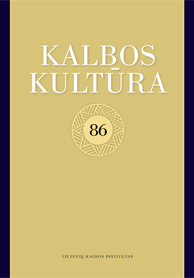ŽODŽIŲ KRŪMAS, PUSKRŪMIS, KRŪMOKŠNIS, KRŪMELIS SAMPRATA (REMIANTIS STUDENTŲ APKLAUSA)
THE PERCEPTION OF THE WORDS KRŪMAS, PUSKRŪMIS, KRŪMOKŠNIS, KRŪMELIS (SHRUB, SUBSHRUB, BUSH, SMALL SHRUB); BASED ON A STUDENT SURVEY
Author(s): Danutė Liutkevičienė, Anželika GaidienėSubject(s): Theoretical Linguistics, Applied Linguistics, Semantics, Baltic Languages
Published by: Lietuvių Kalbos Institutas
Keywords: survey; meaning; semantic analysis; attribute; definition; terminology; shrub; subshrub; bush; small shrub;
Summary/Abstract: It has been noticed that people rarely differentiate between the words krūmas (shrub), puskrūmis (subshrub), and krūmokšnis (bush), even though the words have different terminological meanings. This study aimed to investigate the contemporary rather than terminological daily perception of these words. A survey of students was chosen as an instrument of enquiry. Analysis of the data has showed that the respondents listed 20 attributes of the shrub (Lith. krūmas). The most frequent description of the shrub was that ‘a shrub is a plant’. Other most typical attributes of the shrub have to do with its exterior: ‘the size of the shrub, ‘how branchy it is’, ‘the qualities of its trunk’, ‘how leafy or thorny it is’, ‘how thick or lush it is’. Several interior attributes of the shrub were mentioned as well, and included qualities such as ‘woodiness’, ‘the characteristics of the bush lifecycle’, and so on. A review of the survey forms has revealed the knowledge of the subshrub (Lith. puskrūmis) to be much poorer than that of the shrub. A lot of the respondents did not know what a subshrub was or thought it was completely the same as the shrub. A total of 12 subshrub attributes were named. Some of the respondents described the subshrub on the basis of its formational meaning: ‘half a shrub’ or ‘semi-shrub’. These replies have nothing to do with the terminological meaning of subshrub. Strangely, quite a few of the respondents connected the subshrub with a tree rather than a shrub, believing this plant to bear more semblance to the first rather than the latter. The most frequent exterior attributes of the subshrub mentioned were its ‘size’, ‘trunk properties’, ‘rarity’. Notably, these attributes differ from what encyclopaedias have to say. Several respondents also mentioned some interior attributes of the subshrub: ‘subshrub’s woodiness’ and that the subshrub is a ‘perennial plant’. These answers conform to the attributes of the subshrub that its terminological meaning refers to.
Journal: Bendrinė kalba (iki 2014 metų – Kalbos kultūra)
- Issue Year: 2019
- Issue No: 92
- Page Range: 1-33
- Page Count: 33
- Language: Lithuanian

